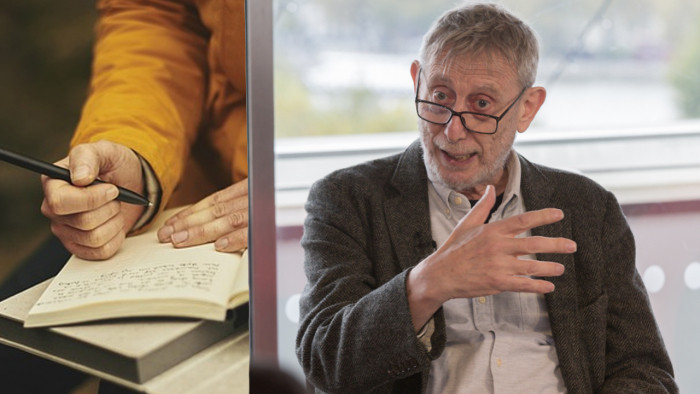Mornings: you groggily emerge from your bleary-eyed state, fumbling for the snooze button while steering well clear of that drool patch on the pillow. Then after downing your first coffee of the day, you proceed to type the final chapter to one of the best-selling novels ever written.
Okay, so perhaps you play Angry Birds instead. But whatever your reason for not penning a masterpiece, you can be sure that your own daily habits don't stray too far from those used by famous authors - past and present - to trigger their creative spark.
For new book Rituals: How Great Minds Make Time, Find Inspiration, And Get To Work, New York-based author Mason Curry has listed 161 famous names and the 161 very different ways they approached their work. You might even be surprised by a few.
So take a look at the 10 literary examples we've exclusively taken from the new book, below, and marvel at how some of your finest books were forged...
Daily Rituals is published by Picador and out on 11th September; RRP £8.99
___________________________________________________________
Jane Austen
Austen rose early, before the other women were up, and played the piano. At 9:00 she organised the family breakfast, her one major piece of household work. Then she settled down to write in the sitting room, often with her mother and sister sewing quietly nearby. If visitors showed up, she would hide her papers and join in the sewing. Dinner, the main meal of the day, was served between 3:00 and 4:00. Afterward there was conversation, card games, and tea. The evening was spent reading aloud from novels, and during this time Austen would read her work-in-progress to her family.
___________________________________________________________
Victor Hugo
Hugo wrote each morning, standing at a small desk in front of a mirror.
He rose at dawn, awakened by the daily gunshot from a nearby fort, and received a pot of freshly brewed coffee and his morning letter from Juliette Drouet, his mistress, who he had installed on Guernsey just nine doors down. After reading the passionate words of “Juju” to her “beloved Christ,” Hugo swallowed two raw eggs, enclosed himself in his lookout, and then wrote until 11:00 A.M.
___________________________________________________________
Mark Twain
His routine was simple: he would go to the study in the morning after a hearty breakfast and stat there until dinner at about 5:00. Since he skipped lunch, and since his family would not venture near the study – they would blow a horn if they needed him – he could usually work uninterruptedly for several hours. “On hot days” he wrote to a friend, “I spread the study wide open, anchor my papers down with brickbats, and write in the midst of the hurricane, clothed in the same linen we make shirts of.”
___________________________________________________________
Stephen King
King writes every day of the year, including his birthday and holidays, and he almost never lets himself quit before he reaches his daily quota of two thousand words. He works in the mornings, starting around 8:00 or 8:30. Some days he finishes up as early as 11.30, but more often it takes him until about 1:30 to meet his goal. Then he has the afternoons and evenings free for naps, letters, reading, family, and Red Sox games on TV.
___________________________________________________________
Franz Kafka
In 1908, Kafka landed a position at the Worker’s Accident Insurance Institute in Prague, where he was fortunate to be on the coveted “single shift” system.
[He] was living with his family in a cramped apartment, where he could muster the concentration to write only late at night, when everyone else was asleep. As Kafka wrote to Felice Bauer in 1912, “time is short, my strength is limited, the office is a horror, the apartment is noisy, and if a pleasant, straight forward life is not possible then one must try to wriggle through by subtle maneuvers. In the same letter he goes on to describe his timetable: “…at 10.30 (but often not till 11.30) I sit down to write, and I go on, depending on my strength, inclination, and luck, until 1, 2 or 3 o’clock, once even till 6 in the morning.”
___________________________________________________________
Leo Tolstoy
“I must write each day without fail, not so much for the success of the work, as in order not to get out of my routine.” This is Tolstoy in one of the relatively few diary entries he made during the mid-1860s, when he was deep into the writing of War and Peace.
According to Sergei [his son], Tolstoy worked in isolation – no one was allowed to enter his study, and the doors to the adjoining rooms were locked to ensure that he would not be interrupted.
___________________________________________________________
Charles Dickens
First, he needed absolute quiet; at one of his houses, an extra door had to be installed to his study to block out noise.
And his study had to be precisely arranged, with his writing desk placed in front of a window and, on the desk itself, his writing materials - goose-quill pens and blue ink – laid out alongside several ornaments: a small vase of fresh flowers, a large paper knife, a gilt leaf with a rabbit perched upon it, and two bronze statuettes (one depicting a pair of fat toads duelling, the other a gentleman swarmed with puppies).
___________________________________________________________
George Orwell
The post at Booklovers’ Corner [a London second-hand bookshop where he was a part-time assistant] proved an ideal fit for the thirty-one-year-old bachelor. Waking at 7:00, Orwell went to open the shop at 8.45 and stayed there for an hour. Then he had free time until 2:00, when he would return to the shop and work until 6.30. This left him almost four and a half hours of writing time in the morning and early afternoon, which conveniently, were the times that he was most mentally alert.
___________________________________________________________
Haruki Murakami
When he is writing a novel, Murakami wakes at 4:00 A.M. and works for five to six hours straight. In the afternoons he runs or swims (or does both), runs errands, reads, and listens to music; bedtime is 9:00. “I keep to this routine every day without variation,” he told The Paris Review in 2004. “The repetition itself becomes the most important thing; it’s a form of mesmerism. I mesmerize myself to reach a deeper state of mind.”
The one drawback to this self-made schedule, Murakami admitted in a 2008 essay, is that it doesn’t allow for much of a social life.
___________________________________________________________
Simone De Beauvoir
Although Beauvoir’s work came first, her daily schedule also revolved around her relationship with Jean-Paul Sartre, which lasted from 1929 until his death in 1980. (Theirs was an intellectual sponsored_longform with a somewhat creepy sexual component; according to a pact proposed by Sartre at the outset of their relationship, both partners could take lovers, but they were required to tell each other everything.) Generally, Beauvoir worked by herself in the morning, then joined Sartre for lunch. In the afternoon they worked together in silence at Sartre’s apartment. In the evening, they went to whatever political or social event was on Sartre’s schedule, or else went to the movies or drank Scotch and listened to the radio at Beauvoir’s apartment.
___________________________________________________________
Daily Rituals is published by Picador and out on 11th September; RRP £8.99
[Images: Rex, Wiki Commons, Science Image Library, Getty]










